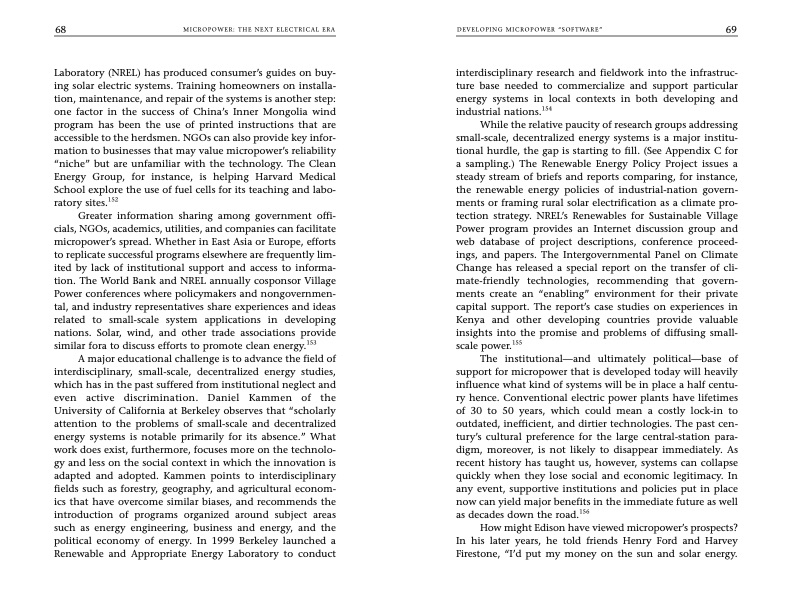
PDF Publication Title:
Text from PDF Page: 035
68 MICROPOWER: THE NEXT ELECTRICAL ERA DEVELOPING MICROPOWER “SOFTWARE” 69 Laboratory (NREL) has produced consumer’s guides on buy- ing solar electric systems. Training homeowners on installa- tion, maintenance, and repair of the systems is another step: one factor in the success of China’s Inner Mongolia wind program has been the use of printed instructions that are accessible to the herdsmen. NGOs can also provide key infor- mation to businesses that may value micropower’s reliability “niche” but are unfamiliar with the technology. The Clean Energy Group, for instance, is helping Harvard Medical School explore the use of fuel cells for its teaching and labo- ratory sites.152 Greater information sharing among government offi- cials, NGOs, academics, utilities, and companies can facilitate micropower’s spread. Whether in East Asia or Europe, efforts to replicate successful programs elsewhere are frequently lim- ited by lack of institutional support and access to informa- tion. The World Bank and NREL annually cosponsor Village Power conferences where policymakers and nongovernmen- tal, and industry representatives share experiences and ideas related to small-scale system applications in developing nations. Solar, wind, and other trade associations provide similar fora to discuss efforts to promote clean energy.153 A major educational challenge is to advance the field of interdisciplinary, small-scale, decentralized energy studies, which has in the past suffered from institutional neglect and even active discrimination. Daniel Kammen of the University of California at Berkeley observes that “scholarly attention to the problems of small-scale and decentralized energy systems is notable primarily for its absence.” What work does exist, furthermore, focuses more on the technolo- gy and less on the social context in which the innovation is adapted and adopted. Kammen points to interdisciplinary fields such as forestry, geography, and agricultural econom- ics that have overcome similar biases, and recommends the introduction of programs organized around subject areas such as energy engineering, business and energy, and the political economy of energy. In 1999 Berkeley launched a Renewable and Appropriate Energy Laboratory to conduct interdisciplinary research and fieldwork into the infrastruc- ture base needed to commercialize and support particular energy systems in local contexts in both developing and industrial nations.154 While the relative paucity of research groups addressing small-scale, decentralized energy systems is a major institu- tional hurdle, the gap is starting to fill. (See Appendix C for a sampling.) The Renewable Energy Policy Project issues a steady stream of briefs and reports comparing, for instance, the renewable energy policies of industrial-nation govern- ments or framing rural solar electrification as a climate pro- tection strategy. NREL’s Renewables for Sustainable Village Power program provides an Internet discussion group and web database of project descriptions, conference proceed- ings, and papers. The Intergovernmental Panel on Climate Change has released a special report on the transfer of cli- mate-friendly technologies, recommending that govern- ments create an “enabling” environment for their private capital support. The report’s case studies on experiences in Kenya and other developing countries provide valuable insights into the promise and problems of diffusing small- scale power.155 The institutional—and ultimately political—base of support for micropower that is developed today will heavily influence what kind of systems will be in place a half centu- ry hence. Conventional electric power plants have lifetimes of 30 to 50 years, which could mean a costly lock-in to outdated, inefficient, and dirtier technologies. The past cen- tury’s cultural preference for the large central-station para- digm, moreover, is not likely to disappear immediately. As recent history has taught us, however, systems can collapse quickly when they lose social and economic legitimacy. In any event, supportive institutions and policies put in place now can yield major benefits in the immediate future as well as decades down the road.156 How might Edison have viewed micropower’s prospects? In his later years, he told friends Henry Ford and Harvey Firestone, “I’d put my money on the sun and solar energy.PDF Image | Micropower: The Next Electrical Era

PDF Search Title:
Micropower: The Next Electrical EraOriginal File Name Searched:
EWP151.pdfDIY PDF Search: Google It | Yahoo | Bing
Capstone Turbine and Microturbine: Capstone microturbines used and new surplus for sale listing More Info
Consulting and Strategy Services: Need help with Capstone Turbine, sizing systems, applications, or renewable energy strategy, we are here to assist More Info
Container Lumber Dry Kiln: Since 1991 developing and innovating dry kilns using standard shipping containers More Info
Supercritical CO2 Lumber Dry Kiln: Compact fast drying in 3 days or less for small amounts of wood and lumber drying More Info
BitCoin Mining: Bitcoin Mining and Cryptocurrency... More Info
Publications: Capstone Turbine publications for microturbine and distributed energy More Info
FileMaker Software for Renewable Energy Developing database software for the renewable energy industry More Info
CO2 Gas to Liquids On-Demand Production Cart Developing a supercritical CO2 to alcohol on-demand production system (via Nafion reverse fuel cell) More Info
Stranded Gas for low cost power Bitcoin Mining Using stranded gas for generators may provide breakthrough low power costs for cryptocurrency miners. More Info
| CONTACT TEL: 608-238-6001 Email: greg@globalmicroturbine.com | RSS | AMP |